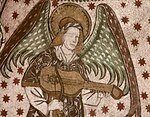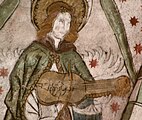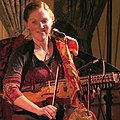
Nyckelharpa
Stemming from Sweden, the nyckelharpa (Swedish: [ˈnʏ̂kːɛlˌharːpa], plural nyckelharpor), meaning "keyed fiddle" or "key harp"(lit.), is a bowed chordophone, similar in appearance to a fiddle or violin but larger (in its earlier forms essentially a modified vielle), which employs key-actuated tangents along the neck to change the pitch during play, much like a hurdy-gurdy. The keys slide under the strings, with the tangents set perpendicularly to the keys, reaching above the strings. Upon key-actuation, the tangent is pressed to meet the corresponding string, much like a fret, shortening its vibrating length to that point, changing the pitch of the string.[2][3] It is primarily played underarm, suspended from the shoulder using a sling, with the bow in the overhanging arm.
String instrument
321.322–71
12th century
2023 (18th session)
Good Safeguarding Practices
The origin of the instrument is unknown, but its historical foothold and modern development is much larger in Sweden than other countries. Many of the early historical depictions of the instrument are found in Sweden, the earliest possibly depiction found on a relief located on a 14th century church portal. While historically not too common of an instrument in Sweden (relatively speaking), the violin outshining it in usage among spelmän (players of Swedish folk music), the nyckelharpa became a popular folk instrument in the Swedish province of Uppland during the 17th century, subsequently leading to its popularization and spread throughout Sweden the following centuries. By the 19th century it had become a "fine" instrument, being played at concerts in Stockholm,[4] and by the early 20th century it had become an archetypal instrument alongside the violin for Swedish folk music. Today it is considered by many to be the quintessential national instrument of Sweden.[5] The oldest surviving nyckelharpa is dated 1526 and is part of the Zorn Collections in Mora Municipality, Sweden.[4]
Besides Sweden, early depictions of nyckelharpor can also be found in Denmark, Germany and Italy, among other European countries. The earliest of these is found in a 1408 fresco by Taddeo di Bartolo at the Palazzo Pubblico chapel in Siena, Italy, which depicts an angel playing a "keyed viola". Recently there has been a push by luthiers and the like to make recreations of these older depictions of nyckelharpor, akin to reconstructional archaeology,[6] but also new instruments based on the nyckelharpa concept of a keyed bow instrument.[7]







